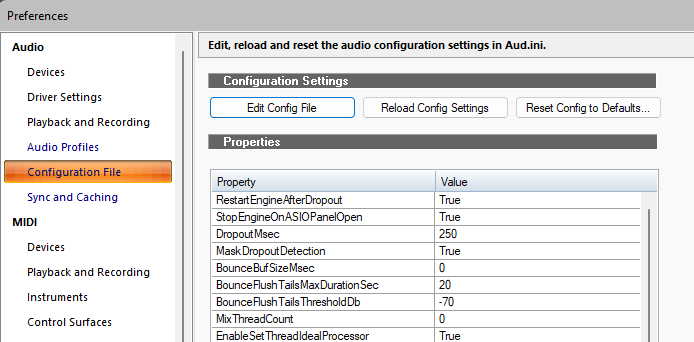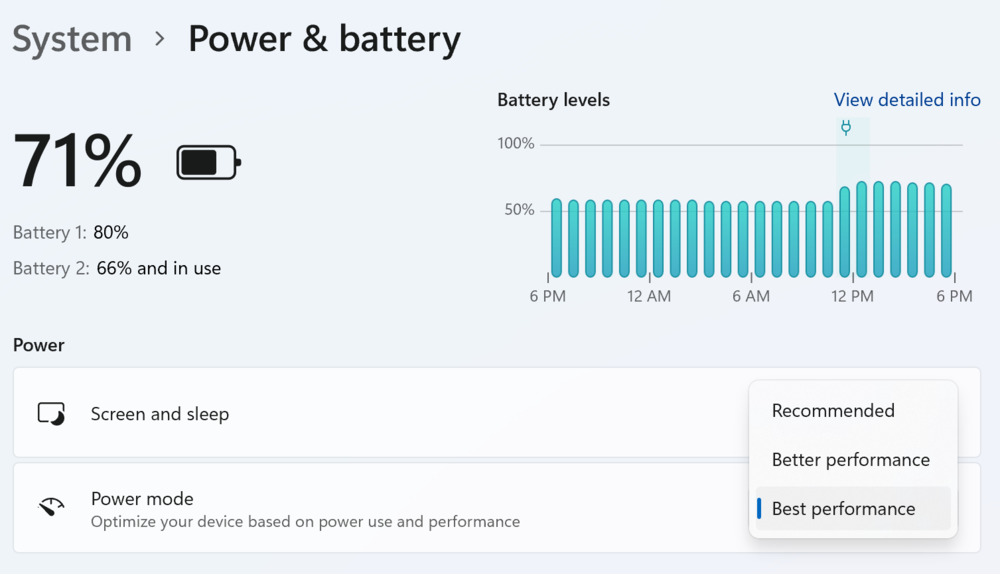-
Posts
4,208 -
Joined
-
Last visited
-
Days Won
46
Everything posted by Noel Borthwick
-
@pulsewalk If you have a problem that is project specific as it certainly appears to be in your case, the only hope to resolve the issue is to send us the project file. In many cases we don’t even require the audio data to identify problems so you could try sending just the cwp file first. Cakewalk does not share user data with anyone so copyright should not be an issue here.
-
I have literally never heard of this issue. There is no “migration” unless you are loading really old projects from the 90’s with the wrk file format! Products from the X series all load natively since the project files are backwards compatible. You mention LUA scripts - that is not specific to Cakewalk perhaps some third party wrapper is throwing those errors.
-

Why is Cakewalk favoring core 1 so much?
Noel Borthwick replied to RexRed's topic in Cakewalk by BandLab
Some notes. Make sure performance module is set to audio engine performance rather than system load otherwise its showing performance of the system as a whole not Cakewalk. The measurement of engine performance is an “estimate” so don’t read too much into the metering. There is no perfect way for an app to measure core performance at the app level in Windows. Its intended for troubleshooting only. The bottom line is whether you actually hear glitches. The app is at the mercy of the windows scheduler so we cannot control which core gets the most cycles. Especially with some of the modern big/little core CPU’s as well as hyperthreading this is not deterministic anymore. Also one of the cores gets assigned to user interface. The audio engine can get assigned to the same core being used by the UI by windows so its not abnormal at all to see more load on one core. Load balancing is not a perfect science so I wouldnt get too hung up on seeing perfect distribution of workloads. Depending on how your project is set up and the plugins its normal to see variances. -

Cakewalk 2022.11 by Bandlab more efficient than PT 2022
Noel Borthwick replied to Dagg M.'s topic in Cakewalk by BandLab
You definitely want to check out workspaces since this allows you to hide as much of the user interface as necessary. This is a unique customization feature in cakewalk that other daws do not have. You likely have the default set to the advanced workspace, that literally shows all of the UI. Try setting it to basic or mixing, or create your own workspace to your taste to show just what you need. -
For the record. I connected to Michael's PC via teamviewer and resolved it. ActController was crashing on startup for some reason (likely the act data got messed up when he had the Nanocontrol) I found the crash by launching Cakewalk inside windebug which showed the crash site. Then I renamed his actcontroller dll and Cakewalk immediately started up. After that I removed it from preferences control surfaces, renamed the dll back and added it back to surfaces. Its working fine for him now. Windebug is the best tool to troubleshoot issues like this when the app is not launching or poofing because it will always show the reason for the exit.
-

bug report I think I came across an interesting bug
Noel Borthwick replied to OddSox's topic in Cakewalk by BandLab
@OddSox The file was not available when I tried to get it. We look at dump files in Visual studio directly since we have the symbols. Windebug also works. However. without symbols you won't see very much . -

bug report I think I came across an interesting bug
Noel Borthwick replied to OddSox's topic in Cakewalk by BandLab
@fossile the actual issue isnt related to pan law. When you bounce with source category clips, it's running each selected clip through the entire signal flow and captures the "as heard" sound. However, when it encounters a mono clip with channel format mono (or follow source), the clip gets upconverted to stereo at the end of the bounce signal path and then it gets converted back to mono when writing the file. this is where the 3db gain comes into play. I've fixed this by compensating for it for the next version. -
There is really no reason to install asio4all for an audio device that has a manufacturer provided asio driver. At best it will perform worse than the native driver. At worst it will cause pain because it grabs ownership of the underlying wdm driver and will cause grief if you use the native driver.
-

bug report I think I came across an interesting bug
Noel Borthwick replied to OddSox's topic in Cakewalk by BandLab
If you can upload the crash dump or PM it to me we can take a look. -
@Christopher Hunt Technically ASIO is a wrapper on top of the OS native driver model which is WDM. i.e an ASIO “driver” vendor must also ship a WDM driver for Windows itself to communicate with the device. There is no other way. So every device that has an ASIO driver needs to support Windows using the device at the SAME time as a DAW uses it via ASIO. Some devices do this well and others handle it poorly. For example Windows may be using the device at one sample rate while the DAW is using it at another. A well behaved driver handles all these scenarios transparently. All MMCSS does is set an elevated priority for the driver thread. This tells Windows to not interrupt the driver when doing other tasks which is useful when operating at low latencies. Cakewalk has supported MMCSS from day one when it was made available in Windows. At the time it was not part of the ASIO specification at all and almost no drivers supported it directly except a few like RME. So Cakewalk would set the drivers thread to MMCSS mode automatically to benefit from this (controlled by the MMCSS flag). This setting however was for both Cakewalk as well as the driver, until our recent release where we made it granular so it could be independently switched off for the driver. The reason for this was to avoid certain (buggy) drivers that caused problems when forced to MMCSS mode. The ASIO specification now states that ALL drivers should run in MMCSS mode but its still widely not respected. Pretty much the wild west out there Its not surprising because its an internal option that end users shouldn‘t need to worry about. In reality that isnt the case Most drivers don’t have a checkbox for this so its very hard to find out if the driver supports it without using tools like Process Monitor and even so its hard to find the driver thread most of the time. In Cakewalk I added a status if you hover over the performance module that shows the thread priority. If its 18 or higher its typically means that the driver is in MMCSS mode. However the technique I use to detect it isnt foolproof (Microsoft doesnt publish a way to check this!) Always choose ASIO inside the DAW. If you can use a different device for windows its preferable since it eliminates one common problem from the equation, since some drivers don’t play well when used simultaneously. I haven’t had issues with RME being used by Windows and Cakewalk simultaneously however. See my above notes. The technique I use isn’t perfect so if the driver has actually set it to MMCSS sometimes we just get a failure code when trying to set it to MMCSS but I can’t conclusively know if its actually running in MMCSS without running process monitor,
-
This has never worked with certain video formats. It didn’t work in SONAR as well. I’ve fixed it for the next release.
-

No audio unless whole project in solo
Noel Borthwick replied to Michael Reynolds's topic in Cakewalk by BandLab
If your send a link to your project I can take as look at it. -

Cakewalk slow at adding new tracks and other things
Noel Borthwick replied to RexRed's topic in Cakewalk by BandLab
Its pretty interesting that the issue occurs only on an AMD machine. I'll look into it some more but adding tracks have much interaction with the audio driver so that part is puzzling to me. Unfortunately, we don't have any AMD machines anymore to run tests on or I would have tried it. -

Cakewalk does not see the headset
Noel Borthwick replied to Aloe Duke's topic in Cakewalk by BandLab
Make sure you set cakewalk to run in WASAPI shared mode and select the headphone device as an output for your master bus. -
@Light Grenade if you have a link PM it to me.
-

Outputs 1&2 not come out of Lynx Aurora (n)
Noel Borthwick replied to AB77's topic in Cakewalk by BandLab
Moot. I've fenced it out of the next release of Cakewalk -

Outputs 1&2 not come out of Lynx Aurora (n)
Noel Borthwick replied to AB77's topic in Cakewalk by BandLab
Honestly it has no use especially in ASIO mode. Maybe we should just block it unless in MME or WASAPI shared. -

Outputs 1&2 not come out of Lynx Aurora (n)
Noel Borthwick replied to AB77's topic in Cakewalk by BandLab
Interesting. The wavetable synth from Microsoft internally outputs to the default audio output. So if Windows is using your Lynx its likely blocking the device. I've never seen this happen with other audio devices so you should report that to Lynx. I would expect the driver to share the audio device with both Windows and the ASIO driver client. But yeah disable the wavetable synth. It's a piece of junk that dates back to the 90's Here is an article on how to disable it in Windows. https://answers.microsoft.com/en-us/windows/forum/all/completely-disabling-ms-gs-wavetable-synth/5b2297a5-0904-4340-bdbb-ce528b3068c5 Maybe we should block it in Cakewalk itself by default... -

Cakewalk slow at adding new tracks and other things
Noel Borthwick replied to RexRed's topic in Cakewalk by BandLab
Sorry that you are having such a nightmare with Windows. I have an RME UFX but it runs on one of my older computers with Windows 10 on it. I don't see any significant lags when adding tracks. I tested adding about 50 tracks and it still took about a second to add a new track after that. This is an older PC about 8 years old. I doubt that this is a Windows issue or RME issue directly. Have you tried resetting your audio configuration to defaults in preferences / Configuration file? Does the slowness even happen on a new empty project? One more thing to try. In preferences, disable all audio inputs and outputs except for the ones you are using. See if this makes a difference. -

Outputs 1&2 not come out of Lynx Aurora (n)
Noel Borthwick replied to AB77's topic in Cakewalk by BandLab
If you were using ASIO and output 1/2 was not working the problem definitely exists outside of Cakewalk. Something in Windows is possibly confusing the ASIO driver. I would ask Lynx support. -

Latency, LatencyMon and Audio Engine dropout
Noel Borthwick replied to Harley Dear's topic in Cakewalk by BandLab
If you are using a laptop definitely make sure windows is set to high performance mode and preferably use it plugged in to AC power. 4) If my laptop is using just battery only ( i.e. not plugged into mains via the adaptor ), would that be more likely to cause 'audio engine dropouts', even though the battery still has ( say ) 50% charge left? When running on battery Windows is very aggressive about conserving power to the detriment of realtime performance. Its not surprising that your system is prone to dropouts. If you must run on battery then you MUST ensure that Windows is set to never sleep and always run in high performance mode. Also run with MMCSS enabled in Cakewalk. Additionally you may turn off dropout detection in Cakewalk by setting MaskDropoutDetection to True. When that is set, the audio engine will not stop even if a dropout is detected. You may hear a momentary glitch bug it will keep running. -

Higher Sample Rates Sound Bad(44100, 4800)
Noel Borthwick replied to Hannah's topic in Cakewalk by BandLab
If using onboard audio make sure that you have set the audio driver mode in Cakewalk to WASAPI Shared here: This is the default for windows onboard audio devices and should work for all sample rates even those that the audio interface doesn't directly support because Windows does the sample rate conversion. In WASAPI shared mode the latency is locked at 10 msec but it should be good enough for most use cases. -
The issue has nothing to do with the audio engine. Its very likely to be a plugin in your project leading to this. Not hardware or Cakewalk itself or even due to a corrupt project. There isn't anything necessarily that we can "fix" without being able to reproduce whatever problem you are seeing or getting a dump file that shows the issue. If the app itself is not hung and you are getting silent audio, the most common cause is that one of your plugins has internally "crashed" and is producing silence or random floating point data. If you can reproduce the issue, use a process of elimination to remove plugins one by one till the project starts working again.
-

Outputs 1&2 not come out of Lynx Aurora (n)
Noel Borthwick replied to AB77's topic in Cakewalk by BandLab
What driver mode are you using in Cakewalk?






